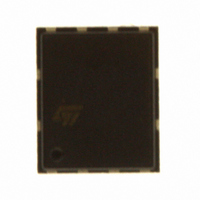M25P10-AVMP6TG NUMONYX, M25P10-AVMP6TG Datasheet - Page 22

M25P10-AVMP6TG
Manufacturer Part Number
M25P10-AVMP6TG
Description
IC FLASH 1MBIT 50MHZ 8VFQFPN
Manufacturer
NUMONYX
Series
Forté™r
Datasheet
1.M25P10-AVMP6TG.pdf
(51 pages)
Specifications of M25P10-AVMP6TG
Format - Memory
FLASH
Memory Type
FLASH
Memory Size
1M (128K x 8)
Speed
50MHz
Interface
SPI, 3-Wire Serial
Voltage - Supply
2.3 V ~ 3.6 V
Operating Temperature
-40°C ~ 85°C
Package / Case
8-VFQFN, 8-VFQFPN
Lead Free Status / RoHS Status
Lead free / RoHS Compliant
Other names
M25P10-AVMP6TG
M25P10-AVMP6TGTR
M25P10-AVMP6TGTR
Available stocks
Company
Part Number
Manufacturer
Quantity
Price
Company:
Part Number:
M25P10-AVMP6TG
Manufacturer:
Micron Technology Inc
Quantity:
10 000
6.5
22/51
Write Status Register (WRSR)
The Write Status Register (WRSR) instruction allows new values to be written to the Status
Register. Before it can be accepted, a Write Enable (WREN) instruction must previously
have been executed. After the Write Enable (WREN) instruction has been decoded and
executed, the device sets the Write Enable Latch (WEL).
The Write Status Register (WRSR) instruction is entered by driving Chip Select (S) Low,
followed by the instruction code and the data byte on Serial Data input (D).
The instruction sequence is shown in
The Write Status Register (WRSR) instruction has no effect on b6, b5, b4, b1 and b0 of the
Status Register. b6, b5 and b4 are always read as 0.
Chip Select (S) must be driven High after the eighth bit of the data byte has been latched in.
If not, the Write Status Register (WRSR) instruction is not executed. As soon as Chip Select
(S) is driven High, the self-timed Write Status Register cycle (whose duration is t
initiated. While the Write Status Register cycle is in progress, the Status Register may still
be read to check the value of the Write In Progress (WIP) bit. The Write In Progress (WIP)
bit is 1 during the self-timed Write Status Register cycle, and is 0 when it is completed. At
some unspecified time before the cycle is completed, the Write Enable Latch (WEL) is reset.
The Write Status Register (WRSR) instruction allows the user to change the values of the
Block Protect (BP1, BP0) bits, to define the size of the area that is to be treated as read-
only, as defined in
user to set or reset the Status Register Write Disable (SRWD) bit in accordance with the
Write Protect (W) signal. The Status Register Write Disable (SRWD) bit and Write Protect
(W) signal allow the device to be put in the Hardware Protected mode (HPM). The Write
Status Register (WRSR) instruction is not executed once the Hardware Protected mode
(HPM) is entered.
The protection features of the device are summarized in
When the Status Register Write Disable (SRWD) bit of the Status Register is 0 (its initial
delivery state), it is possible to write to the Status Register provided that the Write Enable
Latch (WEL) bit has previously been set by a Write Enable (WREN) instruction, regardless
of the whether Write Protect (W) is driven High or Low.
When the Status Register Write Disable (SRWD) bit of the Status Register is set to ‘1’, two
cases need to be considered, depending on the state of Write Protect (W):
If Write Protect (W) is driven High, it is possible to write to the Status Register provided
that the Write Enable Latch (WEL) bit has previously been set by a Write Enable
(WREN) instruction
If Write Protect (W) is driven Low, it is not possible to write to the Status Register even
if the Write Enable Latch (WEL) bit has previously been set by a Write Enable (WREN)
instruction. (Attempts to write to the Status Register are rejected, and are not accepted
for execution). As a consequence, all the data bytes in the memory area that are
software protected (SPM) by the Block Protect (BP1, BP0) bits of the Status Register,
are also hardware protected against data modification.
Table
2. The Write Status Register (WRSR) instruction also allows the
Figure
11.
Table
7.
W
) is
















